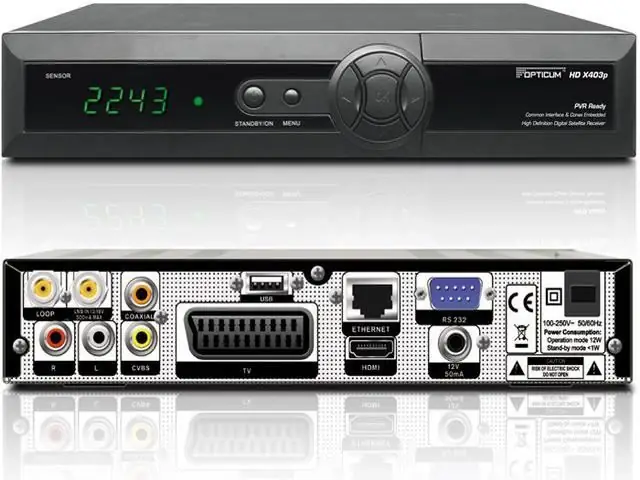Satellite TV allows you to receive digital channels in DVD quality. To do this, use a special device - a receiver, which is connected between the TV and the antenna. Today there is a wide variety of these devices. With their help, you can not only watch TV channels, but also record them on your hard drive, with subsequent viewing at any time. The main thing is to configure it correctly.

It is necessary
- - satellite antenna;
- - satellite receiver;
- - coaxial cable;
- - F-connectors;
- - television
Instructions
Step 1
Install and tune a satellite dish. This can be done using a compass in azimuth or sun. The latter is the more acceptable option.
Step 2
Unplug the satellite receiver's 220V outlet. This is mandatory, otherwise the device may be damaged. Strip the ends of the coaxial cable and fit the F-connectors to it. Make sure that its screen does not touch the central core. Connect the satellite dish to the satellite receiver (tuner) to the LBN IN jack.
Step 3
Connect the receiver to your TV. To do this, on its rear panel there is a set of connectors - scart, tulips, HDMI and antenna output. Make the connection available. After that, on the TV, select any convenient channel, and the satellite receiver will show on it. Turn on the tuner, its display should not light up the clock, but any number. Select the "Channel Search" option and tune the TV to the receiver manually. After that, satellite TV channels will be switched only by the remote control from the receiver.
Step 4
Turn on the MENU button on the tuner or the remote control, then select "Antenna" or "Tuning", or "Install-search for channels", or "Search for channels". Enter the menu for setting LNB, DiSEqC, positioner, 0 / 12V, flash tone.
Step 5
Make sure the required satellite is available in the tuner menu. If it is missing, enter it manually. Check the alignment of the satellite head: linear - universal LNB (frequency 9750/10600), circular - circular LNB (frequency 10750), C band - C-band LNB (frequency 5150). These technical data are written on the satellite converter (head). Select the required satellite and configure the correct DiSEqC port for it. A common option is for 4 ports. If you have one converter, then set to none.
Step 6
When connecting satellite converters to the DiSEqC switch, write down which inputs each converter is connected to. In the tuner menu, set the ports of the DiSEqC switch relative to the connected satellite heads. For example, to tune channels from the Amos 4w satellite, set the Amos 4w satellite and the DiSEqC port to 1/4 (or A) in the setup menu. Scan it. If the result is negative, then set in the settings - the next port, etc. After tuning, proceed to install the next satellite that is tuned to the satellite dish. Check the settings: positioner - off, 0 / 12V - off, tone flash - off, LNB power - on, DiSEqC protocol - set the desired switch, DiSEqC port - set in accordance.
Step 7
Add the desired channel to the satellite receiver. To do this, scan a specific transponder on the desired satellite. You can find out the settings on the website www.flysat.com. In order to scan the transponder, go to the satellite receiver menu in the appropriate section. Select the one you need, if it is not there, then add it manually. Press the button on the tuner remote to scan, this can be determined by the color prompts at the bottom of the TV screen
Step 8
Select manual or automatic scanning. In the latter case, the tuner itself will determine the working transponders that are registered in it, and will display a list of channels. Due to the fact that the position of the satellite is constantly changing, keep an eye on the coming out fresh data. If the settings are incorrect, the screen will remain black.
Step 9
Create a list of the most watched channels. To do this, through the menu of the satellite receiver, mark your favorite channel and indicate in which category to save it. Select the item in the menu "Channel editor - TV channels". Traditionally, these actions are performed using the white button.






